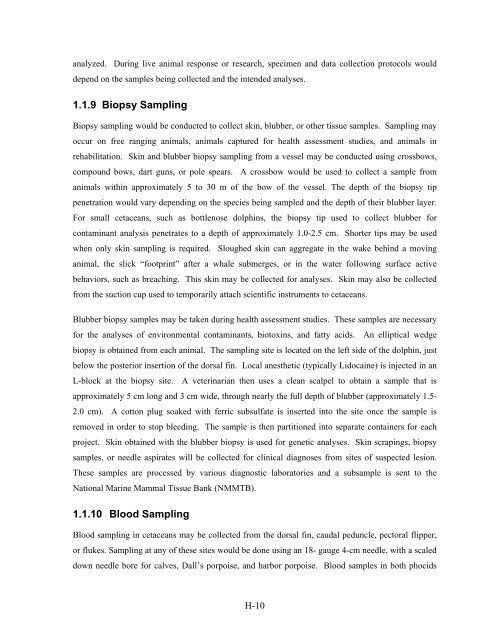Volume III, Appendices EM - National Marine Fisheries Service ...
Volume III, Appendices EM - National Marine Fisheries Service ...
Volume III, Appendices EM - National Marine Fisheries Service ...
You also want an ePaper? Increase the reach of your titles
YUMPU automatically turns print PDFs into web optimized ePapers that Google loves.
analyzed. During live animal response or research, specimen and data collection protocols would<br />
depend on the samples being collected and the intended analyses.<br />
1.1.9 Biopsy Sampling<br />
Biopsy sampling would be conducted to collect skin, blubber, or other tissue samples. Sampling may<br />
occur on free ranging animals, animals captured for health assessment studies, and animals in<br />
rehabilitation. Skin and blubber biopsy sampling from a vessel may be conducted using crossbows,<br />
compound bows, dart guns, or pole spears. A crossbow would be used to collect a sample from<br />
animals within approximately 5 to 30 m of the bow of the vessel. The depth of the biopsy tip<br />
penetration would vary depending on the species being sampled and the depth of their blubber layer.<br />
For small cetaceans, such as bottlenose dolphins, the biopsy tip used to collect blubber for<br />
contaminant analysis penetrates to a depth of approximately 1.0-2.5 cm. Shorter tips may be used<br />
when only skin sampling is required. Sloughed skin can aggregate in the wake behind a moving<br />
animal, the slick “footprint” after a whale submerges, or in the water following surface active<br />
behaviors, such as breaching. This skin may be collected for analyses. Skin may also be collected<br />
from the suction cup used to temporarily attach scientific instruments to cetaceans.<br />
Blubber biopsy samples may be taken during health assessment studies. These samples are necessary<br />
for the analyses of environmental contaminants, biotoxins, and fatty acids. An elliptical wedge<br />
biopsy is obtained from each animal. The sampling site is located on the left side of the dolphin, just<br />
below the posterior insertion of the dorsal fin. Local anesthetic (typically Lidocaine) is injected in an<br />
L-block at the biopsy site. A veterinarian then uses a clean scalpel to obtain a sample that is<br />
approximately 5 cm long and 3 cm wide, through nearly the full depth of blubber (approximately 1.5-<br />
2.0 cm). A cotton plug soaked with ferric subsulfate is inserted into the site once the sample is<br />
removed in order to stop bleeding. The sample is then partitioned into separate containers for each<br />
project. Skin obtained with the blubber biopsy is used for genetic analyses. Skin scrapings, biopsy<br />
samples, or needle aspirates will be collected for clinical diagnoses from sites of suspected lesion.<br />
These samples are processed by various diagnostic laboratories and a subsample is sent to the<br />
<strong>National</strong> <strong>Marine</strong> Mammal Tissue Bank (NMMTB).<br />
1.1.10 Blood Sampling<br />
Blood sampling in cetaceans may be collected from the dorsal fin, caudal peduncle, pectoral flipper,<br />
or flukes. Sampling at any of these sites would be done using an 18- gauge 4-cm needle, with a scaled<br />
down needle bore for calves, Dall’s porpoise, and harbor porpoise. Blood samples in both phocids<br />
H-10
















